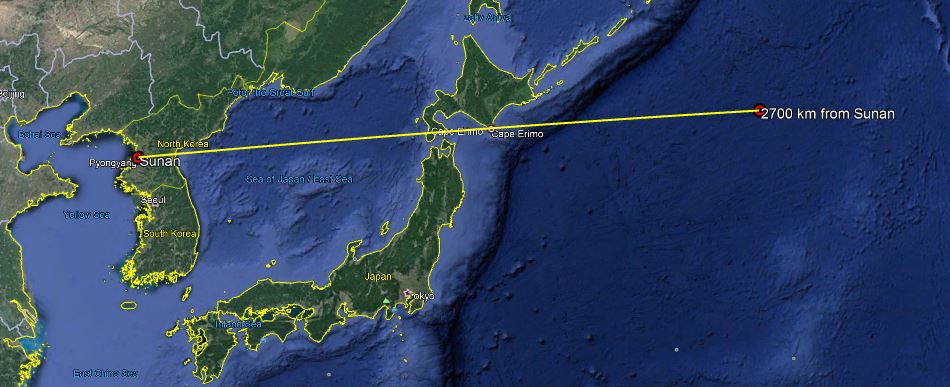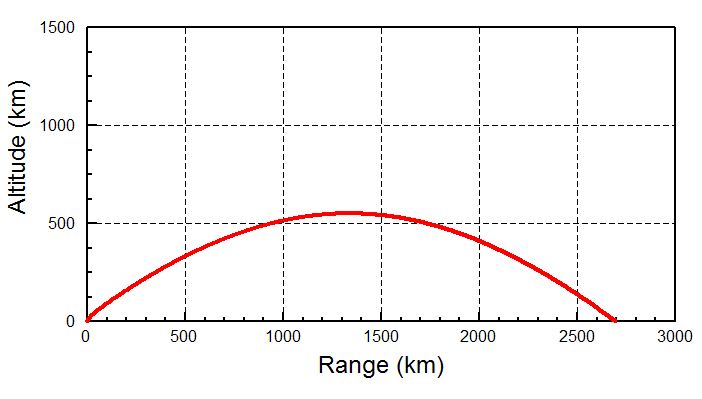Yesterday’s missile launch by North Korea is reported to have been launched from a site near the capitol city of Pyongyang (Sunan) and landed 2,700 kilometers (km) (1,700 miles) to the east after flying over part of the Japanese island of Hokkaido. The missile reportedly flew to a maximum altitude of about 550 km (340 miles), reaching Hokkaido after about eight minutes of flight and splashing down after 14 to 15 minutes.
Fig. 1 shows a possible trajectory for the flight, although it is possible the missile flew somewhat further north and passed over more of Hokkaido.

Fig. 1 (Source: Google Earth)
The launch appears to have been of a Hwasong-12 missile, since it is the only known missile able to reach this distance. The range of this test, however, was much shorter than that of the May 14 test of the Hwasong-12, which would have had a range on a standard trajectory of about 4,800 km (3,000 miles).
What accounts for the shorter range?
One possibility is that the missile was flown with a much larger payload on this flight than on the May 14 test. However, even assuming the May 14 test only carried a payload of 150 kg (corresponding to an empty RV), this launch would have required a payload of about 1,300 kg to give the reported trajectory. That seems unlikely.
A second possibility is that it was flown on a depressed trajectory to reduce the range from 4,800 to 2,700 km. However, that would require a severely depressed trajectory with a burnout angle below nine degrees and a maximum altitude of only 150 km (95 miles). That would also give flight times that were much shorter than those reported.
A more likely reason for a shorter range is a shorter burn time for the engines, either due to North Korea terminating the thrust early to reduce the range, or possibly due to a mechanical problem. In particular, I find if the burn time of the engine is reduced by about eight seconds from the time of about 151 second for the May 14 launch, the missile will fly on the reported trajectory (Fig. 2).
If flown on a standard trajectory (a “minimum-energy trajectory”), a missile with this range would reach a maximum altitude of about 630 km (390 miles) with a burnout angle of 38.1 degrees. The reported altitude of 550 km on yesterday’s launch would mean it was slightly depressed from normal, with a burnout angle of 33.6 degrees. This amount of depression does not seem particularly significant, and may not have been intended.

Fig. 2. The apparent trajectory of yesterday’s launch. Cape Erimo on Hokkaido is at a range of about 1525 km.
A missile on this trajectory would reach the closest part of Hokkaido after eight minutes, which seems to agree with reports. It would pass over Cape Erimo after 9 minutes, and would splash down at 15.5 minutes
Flying over Japan
Yesterday’s launch was the first time North Korea flew a ballistic missile over Japanese territory, although in 1998 and 2009 it launched rockets that overflew Japan on failed attempts to put satellites into orbit. It has gone to some lengths to avoid flying over Japan, by launching its missile tests on highly lofted trajectories so they will land in the Sea of Japan. In addition, it has directed its more recent satellite launches to the south, even though it is preferable to launch to the east—over Japan—since it allows the rocket to gain speed from the rotation of the earth.
After its threats of firing Hwasong-12 missiles near Guam, it is interesting that North Korea fired this missile to the east rather than in the direction of Guam, which might have been interpreted as an attack despite the short range. The missile also appears to have flown in a direction that did not pass over highly populated parts of Japan.
It is not clear what new North Korea would have learned from this launch that is relevant to a long-range missile. It would not have been useful in simulating the reentry forces and heating of a long range missile; in particular, the heating would have been only about half of that on a 10,000 km range missile.
The launch could be useful in getting information about reentry on a standard, non-lofted trajectory with a missile that could reach Guam, although that would require a missile with about 3,400 km range rather than the 2,700 km of this flight.
